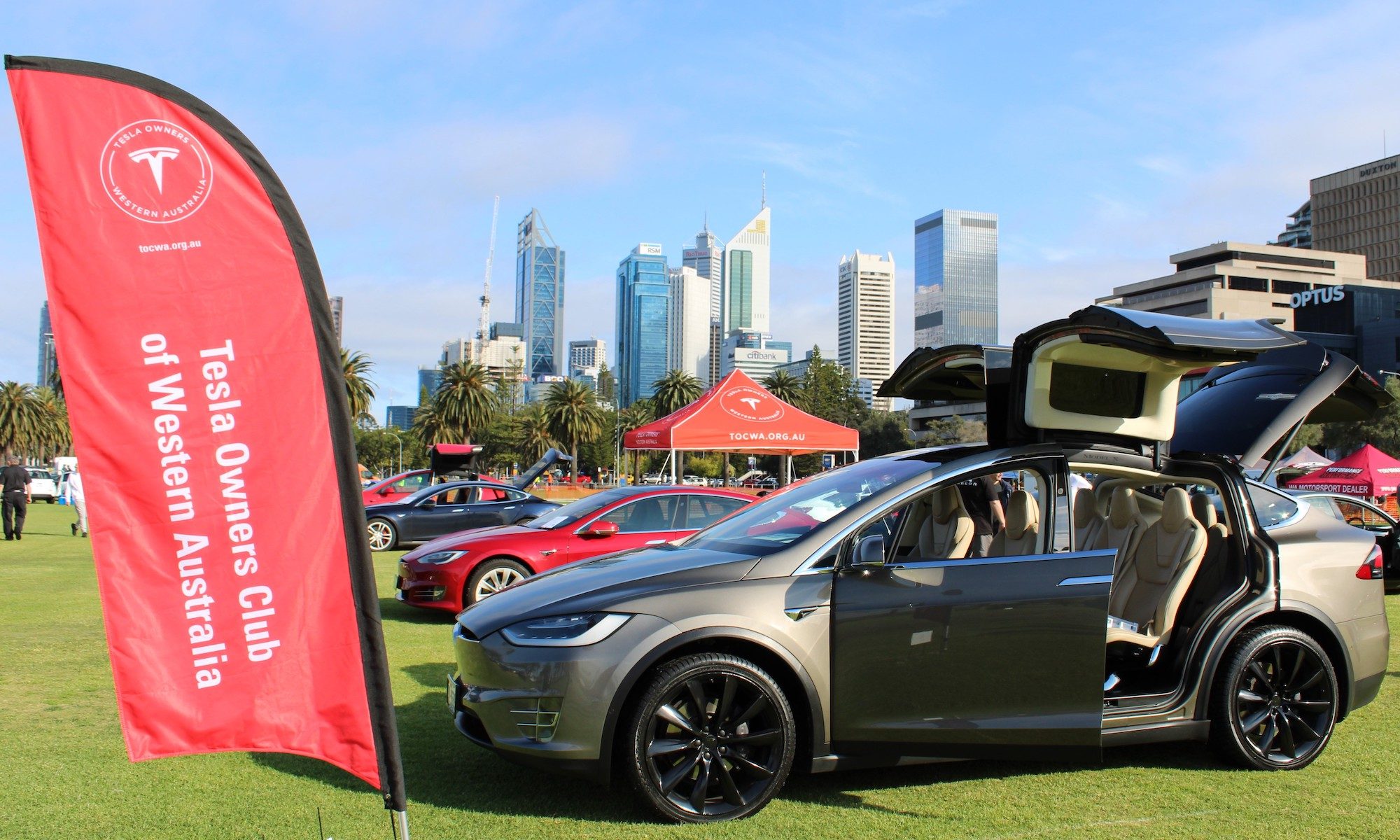In fantastic news for all Tesla owners, we are thrilled to confirm that a supercharger station is being installed in Williams early next year at the Williams Woolshed. It will be a great day when our Eaton Supercharger finally loses its coveted most isolated Supercharger in the world honor.
Why is Tesla battery day a huge deal? It may not be what you think.
If you’re a longer term Tesla follower cast your mind back to March 2016, Tesla were about to display the mass produced Model 3 for the first time and the small (by today’s standards) Tesla fan base were salivating at the thought of a reasonable cost electric vehicle with the style and potential performance of the Tesla Model S. Anyone who had been for a drive in a Tesla product were excited, Legacy auto were not, Tesla was just background noise while they continued building vehicles with 20th century technology. As far as Legacy auto was concerned Tesla was just a niche product purchased by fanatics, the customer base was small and would soon dry up. 48 hours after the Model 3 reveal Tesla had over 300,000 deposits for the model 3, a car many would not receive for over 3 years, that was the last time Legacy auto would underestimate Tesla.
Anything Tesla announce on battery day will gain the full attention of the worlds car makers and likely lead to massive investments in research and development in an attempt to keep up with Tesla, the winners out of this will be the worlds car buyers.
Tesla battery day could bring a battery with better energy density, a battery that will have a useful life of well over a million kilometres, possibly a battery that can be charged at a far faster rate than currently available. It could be none of the above and it still won’t matter, Tesla only need one breakthrough and in the eyes of the fence sitters waiting to buy an electric car a Tesla goes from almost as good as ICE to slightly better than an ICE in total cost of ownership, it doesn’t take much to tip the scales for good.
So what is the most likely announcement on battery day? Amongst many small advancements I think the important one will be faster battery production allowing more efficient use of the facilities and factory workers that will lead to lower costs per kWh of batteries. This reduction in cost may only be 15 to 20% but that’s enough to create the tipping point necessary to assign the internal combustion engine to history.
Discussing EV Charging with Local Government, what’s best? AC or DC charging
One of the best ways to progress electric vehicle charging is through local government, especially in regional areas, shires and councils are always looking to promote their green credentials but more so will listen intently when it’s pointed out that EVs can boost regional tourism.
So what is the best type of charging for shires and councils to install? Read on to get some ideas.
DC charging – obviously it would be preferable to have as many DC fast chargers as possible, it’s also obvious the total install cost makes this extremely difficult unless the charger is donated to the location or there’s a councillor or CEO who’s determined to see EVs progress no matter the cost, this has happened on occasions but is very rare, that’s where AC charging is a good foot in the door.
AC charging – the clear benefit of AC charging is the total installed cost per kW of charging power, to wire in a 3 phase plug would cost $500 at the most, a Tesla HPWC install cost is $1500 at the extreme end of the scale but generally $300 to $700 each, AC charging will provide up to 22kw of charging power to an early Tesla Model S or 11kw to a Model 3. Compared to a 50kw DC charger with a purchase price of $35,000 minimum and install costs between $5000 and $60,000, dependent on the existing electricity infrastructure, you can see the better value of an AC install. The not so known advantage of AC charging is the lack of red tape holding up the install, an electrician will attend the site, make a decision on the the available power supply and if it’s viable the AC charger is installed and operational within a week. DC chargers on the other hand incur a lot of red tape, once every bureaucrat has had their share of the pie the cost and install time frame has become less than reasonable, no doubt when service stations and fast food stores start installing DC chargers the red tape issue will reduce rapidly.
As much as we would all like to see a rapid roll out of DC chargers, promoting AC charging with shires and councils to get the conversation started is the best approach. Very often once a low cost AC charge point is installed and is getting regular use the possibility of a DC charger later in time gets discussed.
Rob Dean
Upcoming Events for September and the School Holidays
We have a few events in the pipeline.
For September, our scheduled casual meetup is at the Camfield:
1 Roger Mackay Drive, Burswood at 7:30pm on September 2nd in place of our usual AUA Zoom Meetup
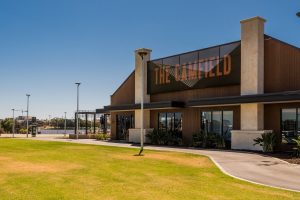
We also have a number of events scheduled in the school holidays
Our October Casual Meetup will be at the annual Rotary Como Car Show at Wesley College, South Perth. If you’re interested in showing off your Tesla, get in touch.
This year the show is on Sunday October 4th, from 10am, Public entry $10 adult, $8 conc., gold coin under 18 – all proceeds to Rotary and Wesley charities.
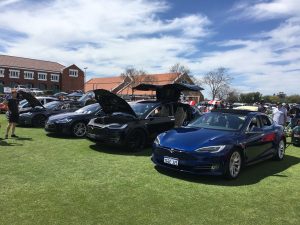
Our other big event for October is our overnight drive to the wheatbelt town of Kulin, home of the famous waterslide, and right in the heart of wildflower country. We’re planning to stay overnight from October 10th to 11th.
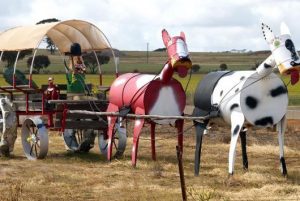
We’ll be limiting the organised drivers to 20 for this drive with convoys taking a pair of routes. There is hotel, AirBnB and camping accomodation options.
How fast is an Electric Car?
Batteries – Horses for Courses.
There’s never a shortage of comments about batteries whenever renewable energy is a topic of discussion. One battery that always gets a mention is the Tesla mega battery in Hornsdale South Australia, it’s held up as a shining light of success and the question is then always asked “why don’t other Australian states commission a mega battery?” Without doubt politics plays a part but more importantly just because the mega battery is a success in SA doesn’t mean it will suit all other states or territories of Australia.
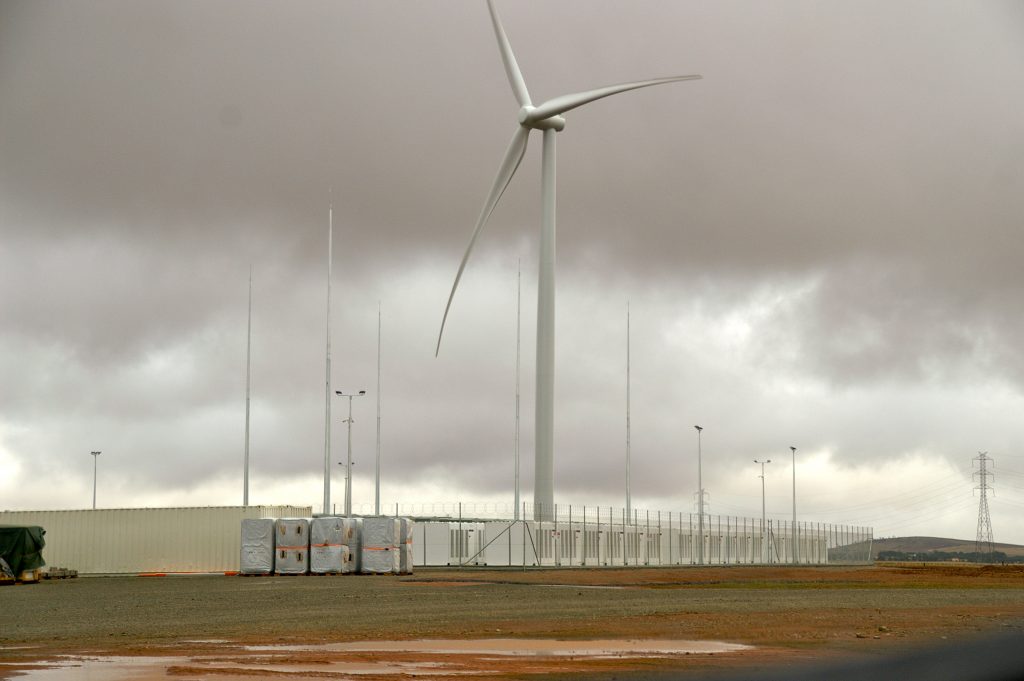
To keep it simple I’ll put batteries into 4 different categories and how they can be useful for one State but not necessarily for another.
Mega Packs such as the Hornsdale battery – The politicians and media who called this a White Elephant back in 2017 have been proved incorrect more than most could ever imagine. The battery’s ability to respond instantly to electricity demand, buying in power at extremely low prices and selling back high is a continual winner for its owners. No doubt this could almost be replicated in some other states with similar electricity production profiles to SA. One thing to remember though is the Hornsdale battery can be likened to the only Taxi in town, add more Taxis and the rewards are less.
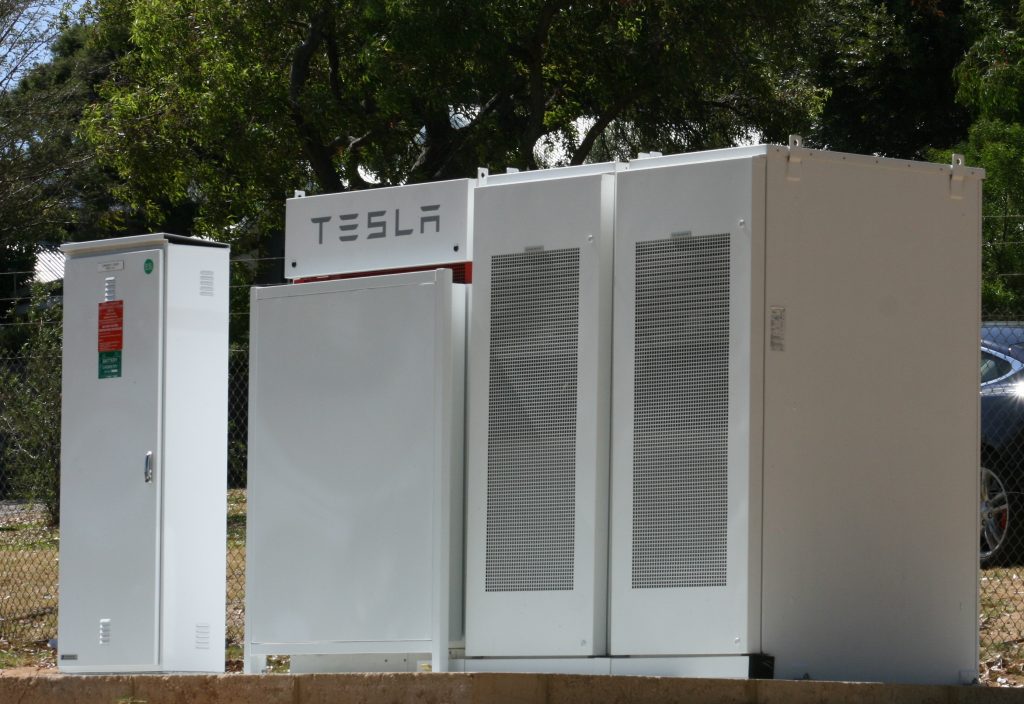
Community battery packs – At the time of writing Western Australia has 13 community battery packs averaging 460kwh capacity each. It would take approximately 400 community battery packs to equal the Hornsdale battery storage but that comparison is not really relevant as they’re performing slightly different tasks. Firstly the community batteries are soaking up local excess daytime solar energy then feeding it back into the grid at the busy dinner time period; secondly its a great marketing exercise from the State’s power providers. All those very visible community batteries are essentially a billboard, no doubt a few locals in each suburb will have the confidence to install their own home battery if the power providers are seen to be supporting the technology, from then on one or two home batteries in each street soon start a trend as prices fall.
Home batteries – For most West Australians these are seen as expensive, without doubt to make it cost effective the home has to be set up to make full use of a battery/solar combination. If your arithmetic still shows the return on investment is not sufficient then the value of having electricity available 24/7 when the grid fails is priceless.
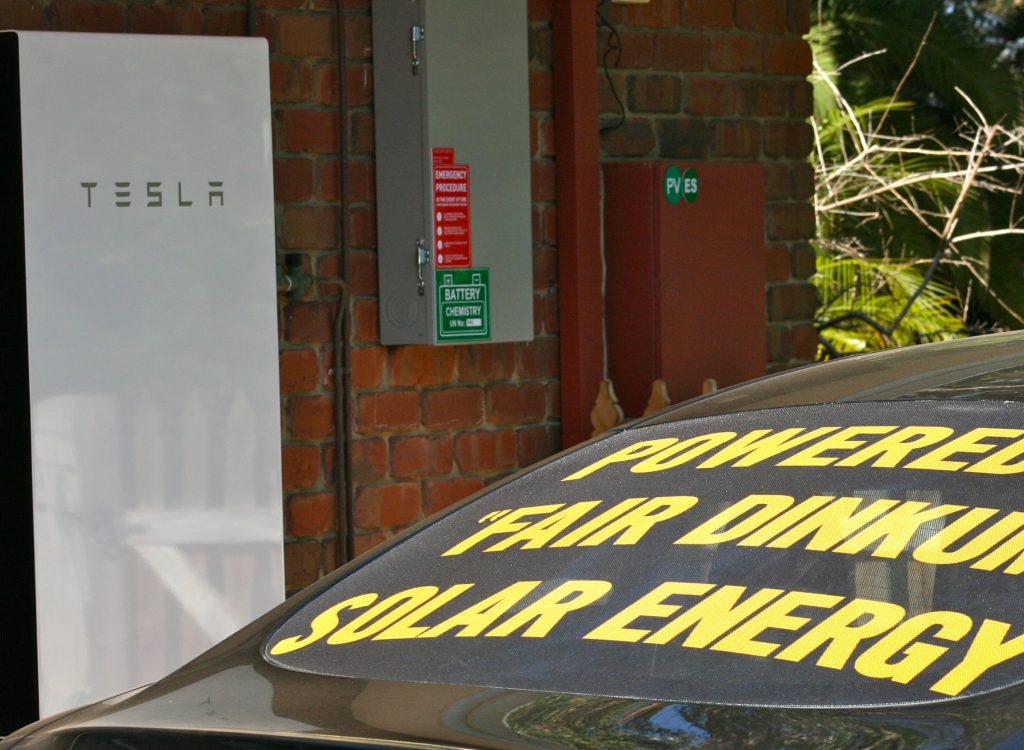
The electric car battery – Although vehicle to grid (V2G) is being trialled in the ACT it’s not critical that this system is up and running immediately, in fact in Western Australia V2G will be far less useful than the Eastern states grid. The most pressing need for the Perth and South west grid is the ability to soak up excess daytime solar, the already high uptake of rooftop solar is increasing month on month. The State’s power grid generates power from Coal, Gas, multiple wind farms and rooftop solar, generation is cheap but matching varying demand with different generation profiles can be a costly exercise for the companies supplying the power. With smart power pricing in times of high solar generation and low consumer demand fleets of electricity vehicles are a great addition to the customer base.
In summary each Australian state will make use of each type of battery depending on their individual needs, for Western Australia the state owned grid operators need to seriously consider the benefits of electric vehicle batteries that are purchased by the vehicle owners but will have a positive impact on the power grid.
Targa South West 2020
This weekend was a milestone for Electric Vehicles with a Telsa Model 3 being the winner of the Targa 130 category in Pemberton on Saturday 8th August. The team of Jurgen and Helen Lunsmann ended the event well ahead of the rest of their field.
Over the years a number of EVs have entered the Targa events in Western Australia with an iMiev, Tesla Model S (non competitive) and BMW i3s enjoying participation. Over recent years Gemtek EV racing have entered the more competitive event with the original Tesla Roadster and now the Tesla Model 3 (thanks to Jon Edwards). With the Roadster the major hurdle was getting enough charge in quickly to stay competitive, this has involved some experimentation with AC charging via a generator.
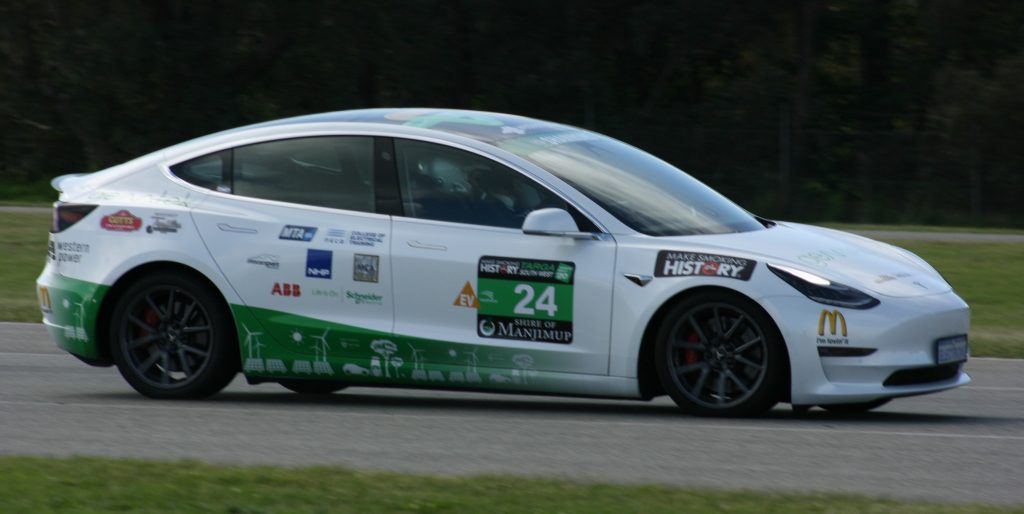
One of the main issues with using a generator was the use of diesel and the usual comments regarding charging an EV from fossil fuels, as well as needing a faster charge. A comparison of charging an EV via a diesel generator and powering a diesel vehicle can be found here. In order to find a faster way to charge has led to the invention of the ChargePod, a fast DC charger connected to a generator (ideal for remote outback charging) which is also able to be fuelled using waste cooking oil. This year at Targa the ChargePod idea was used which enabled not only the competitive Model 3 to complete all stages successfully, but also allowed the 5 Model 3s’ and the converted EV Proton Ute in the Targa Tour to charge. Another more exciting fast charging option this year was the EV to EV charger, a Kona Electric vehicle is able to divert energy from its battery pack via a DC charger attached to the rear cargo area to the Model 3.
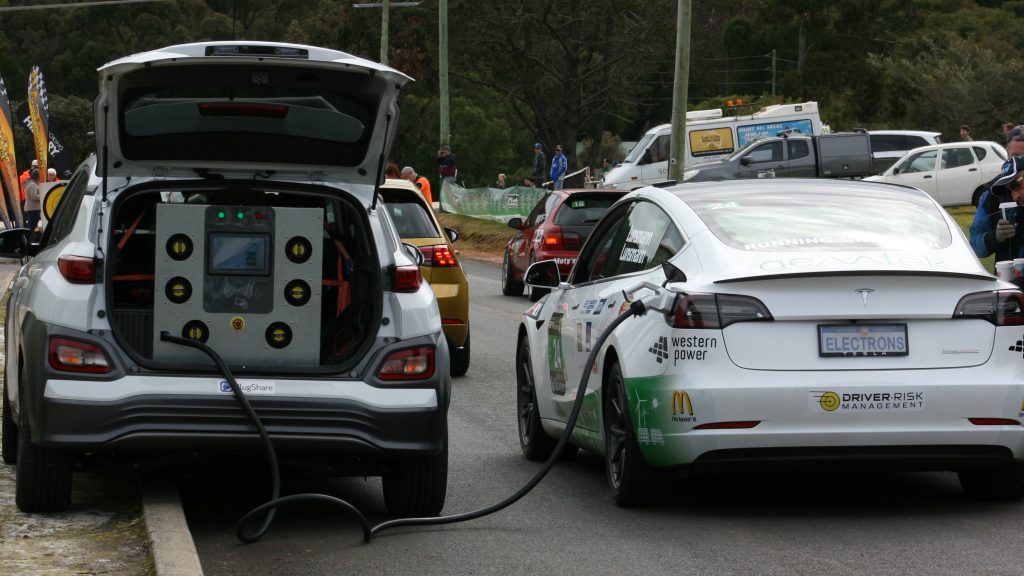
The Targa event in Pemberton consisted of five different stages with multiple runs in each stage: Big Brook; Pump Hill; Northcliffe; Gloucester and Pemberton Town. After the first run the No: 24 Tesla Model 3 in the 130 category already had a 00:15 lead, with the gap lengthening over each run to finally finish with a 04:23 lead (that’s 4 minutes and 23 seconds), Jurgen and Helen were unbeatable by the time they had started the final run. For more details on the days results click here.
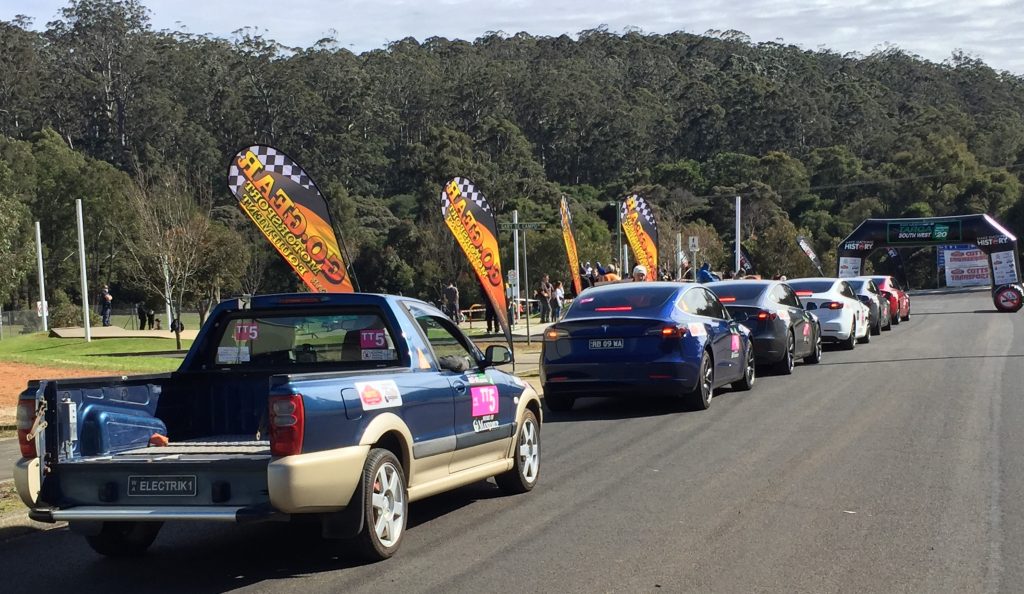
The next Targa West event is scheduled from 22nd to 25th October with stages set in Ellenbrook, Kalamunda, Toodyay, Chittering, Bullsbrook and Malaga, culminating with the Perth City Sprint on the 25th.
Thanks to the enthusiasm of Florian Popp and the Gemtek team and supporters EV’s are making waves in Rally circles.
AUA With James Locke
At last week’s Ask-Us-Anything, we had a special guest in the form of James Locke, formet President of the Vancouver Island Tesla Owners’ Club, now resident in California. James recently had his 2017 Tesla Model S updated with the new infotainment upgrade (MCU2) along with the latest full-self-driving computer.
While these upgrades are not currently available in Australia, it was great to get a perspective on their value in bringing new functionality to a 3-year-old car. Tesla is quite unique in making these retro-fits available.
You can watch our conversations here:
July Fremantle Meetup
Despite the weather, it was great to see some new and old faces in Freo on the weekend. The “cappucino strip” car park chargers were put to good use, and we managed to take over the roof section of the old synagogue café. We also spent some time planning our next road trip – stay tuned for more information soon.
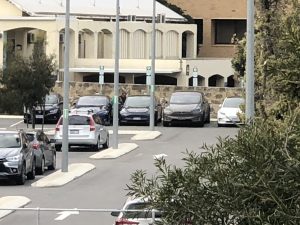
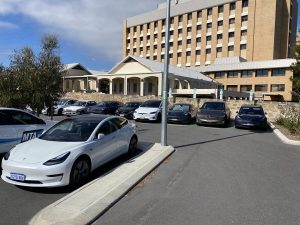
Is an Electric Vehicle a Waste of Resources? Certainly Not, Here’s Why.
It is often claimed that electric vehicles are a failed concept due to the apparent huge amount of resources their batteries consume. I bet you’ve heard it at a BBQ or dinner party from the self proclaimed experts amongst your family, friends or work colleagues. I also bet they threw in statements about Lithium shortages and rare earth metals. Here’s a tip, ask them to name the rare earth metals used in a Tesla Model S battery pack, it’s the last time they’ll ever mention EVs in front of you again.
Please note in the comparison below I am using a Model 3 as it is the most talked about EV at the moment.
To judge the resource intensity of an EV it is best to compare one to a similar size combustion engine car, not one that will only survive the 220,000kms average but a Toyota Camry that if treated with respect should make it to 500,000kms before being scrapped.
A Camry is no match for a long range Model 3 in performance or technology but that’s not the discussion at this time, if we’re going to run a comparison let’s use the best internal combustion engine competitor so there’s no claim of an unfair playing field.
To keep it simple I’ll refer to resources a Model 3 consumes that a Camry doesn’t and vice versa, both cars have seats, door handles, tyres and 12 volt electronics so each car has no disadvantage in that area.
Tesla Model 3
Without going into the finer details of the battery composition a long range Model 3 contains about 500kg of materials. None of them are currently in short supply, in fact all of them have been used in non EV products for many years, this includes the controversial mineral Cobalt that is also used in the oil refining process. Many of the materials are commonly used in the production of ICE vehicles, it’s not like the worlds miners are clearing a whole new jungle just to build electric vehicles.
The AC electric motor/motors plus ancillaries unique to an EV add another 100-150kgs, most of these resources can be recycled but that’s another discussion.
Toyota Camry
The Engine, gearbox, fuel injection system, starter motor, exhaust system, fuel tank and a vastly complicated anti pollution system add up to about 300kg of materials. These are generally very reliable parts but no doubt the exhaust system will need replacing, most importantly the exhaust contains a catalytic converter that is essential to the car reducing its emissions.
The Camry also requires resources for servicing, more than 120 litres of engine oil replaced over 500,000kms, 30+ oil filter changes, fuel filters, air filters, gearbox oil, spark plugs, spark leads, brake pads, engine coolant. Yes, a Model 3 has battery coolant but it generally survives the life of the battery, the coolant in an internal combustion engine works far harder and needs more frequent replacement. As you can see the Camry not only consumes resources in building its drivetrain it also continues to consume them throughout its serviceable life.
Fuel for the Model 3
If you live in Australia and own your home its financial insanity not to be charging from rooftop solar power, if you happen to be part of the majority who do charge from the sun that solar panel system is adding no more than 300kgs of resources to the bottom line, that’s spread over 25 years, about the same time it would take to drive 500,000kms.
For those still charging from the dreaded 100% coal generated electricity (even though the Australian grid is now less than 70% coal generation) your model 3 is going to lead to the consumption of approximately 32,000kgs of coal (22,400kgs at 70% generation), it’s cheap, abundant and locally produced, its also very handy that in Australia the coal is transported from the mine site to the generation facility by a conveyor belt or short train journey. Sadly the multiple toxic elements coal power stations release into the local communities is a major downside.
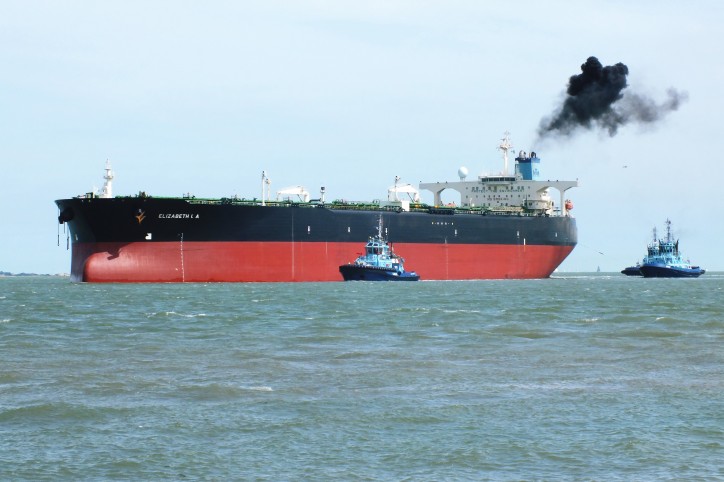
Fuel for the Camry
There is no choice for the Camry, it’s imported oil all the way, shipped across the oceans in bunker fuel burning supertankers, refined in energy hungry oil refineries and trucked to the service station. Over the lifetime of a Camry it will consume approximately 45,000 litres of fuel (34,000kgs), all of it non recyclable.
That 500kg battery pack and 300kg solar panel system doesn’t appear so bad after all.
